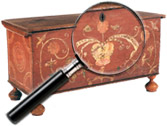|
|
Grant Wood (1891 to 1942)
Grant DeVolson Wood was born February 13, 1891 in Anamosa, Iowa. When he was ten, his father died, prompting the family to relocate to Cedar Rapids, where he eventually found work in a metal-working shop. Finishing high school at Washington High School, he entered art school in Minneapolis in 1910. After a year in Minneapolis, he returned to Iowa and taught at a one-room school. In 1913, he returned [...] Click here to continue reading.
The Sarcophagus in Decorative Arts
Derived from the Greek sarx, meaning flesh, and phagein, meaning eat, a sarcophagus is, essentially, a container for a body, much like a coffin or casket. Historically, sarcophagi were typically made of stone (though sometimes of other materials, such as wood or metal), with a relief-carved or pediment top, and designed to be above ground, and have been used by many cultures since ancient times.
An ancient [...] Click here to continue reading.
William F. “Buffalo Bill” Cody
The year 1883 neatly divides William Cody’s former life as a hunter, scout and guide from his later career as a showman. He was 37 in this year of transition.
The early life of William Frederick Cody (1846 to 1917) was colorful, adventurous and, thanks to Dime novels, exaggerated. He fought for the Union Army in the Civil War at 18. By 21, he earned his lifelong nickname [...] Click here to continue reading.
Panoramic Views
Accurately rendering a panoramic view has long challenged, obsessed and inspired artists. The trend seems to have sprung up in the 17th century, with works that served both as slightly more helpful, more detailed maps with various public or important buildings marked, but also as advertisements for towns and cities. Matthaeus Merian, a Swiss engraver who spent most of his career in Frankfurt, where he also ran a publishing house passed to [...] Click here to continue reading.
James Butler “Wild Bill” Hickok
Unlike the Hollywood nice guy from 1950′s television, the real Wild Bill Hickok was a born killer and compulsive gambler.
Between his birth as James Butler Hickok in 1837 and his 1876 death, Hickok defined the fiercely independent Wild West peacekeeper that never stayed long in one place. Raised to anti-slavery parents in Illinois, Hickok developed a strong sense of loyalty and duty that lasted his entire life. [...] Click here to continue reading.
Thomas Hill (British/American, 1829 to 1908)
Thomas Hill is considered one of the foremost landscape painters of the American West. Born in Birmingham, England, Hill came to the United States a young painter in 1844. His family settled in Massachusetts where Hill apprenticed to a coach painter. In 1853 Hill attended figure painting classes at the Pennsylvania Academy of Fine Arts under the tutelage of Peter Frederick Rothermel (1817-1895). Hill became a successful portraitist [...] Click here to continue reading.
James Rogers Lamantia (American, 1923-2011)
James Lamantia was a noted architect, artist and Emeritus Professor of Architecture at Tulane University. A graduate of Tulane and Harvard Universities and a Rome Scholar, Lamantia worked in architectural firms in both New Orleans and New York. Lamantia was also an accomplished painter; he exhibited his work at the Metropolitan Museum of Art, the Whitney Museum of American Art, and the Chicago Art Institute among others. Most recently [...] Click here to continue reading.
Adolph Gottlieb (American, 1903-1974)
Adolph Gottlieb began a storied career under the leadership of John Sloan and Robert Henri at the Art Students League of New York. Departing for Paris in 1921 to study at the Academie de la Grand Chaumiere before returning to New York in 1923. Gottlieb’s career is described as having four phases: Pictographs (1940s), Grids and Imaginary Landscapes (1951-1957), Busts (1957-1974), and Imaginary Landscapes (1960s). Gottlieb is perhaps best known [...] Click here to continue reading.
Benton Henderson Clark (American, 1895-1964)
First learning drawing under the leadership of artist Arthur Woelfle, Clark went on to study painting at the National Academy of Design in New York in 1913. By 1915 Clark had arrived at the Chicago Art Institute where it is believed he sold a group of his first illustrations. Benton is perhaps best known from his western illustrations appearing in The Saturday Evening Post, McCalls, and Good Housekeeping.
Information [...] Click here to continue reading.
Charles Leslie Thrasher (1889-1936)
The editors of Liberty magazine, which first appeared on the newstand in 1924, prided themselves on innovation – any innovation that would broaden their readership. One of their most successful and appealing ideas was the “continuity cover”, and the artist who took the assignment was Leslie Thrasher. For six years, Thrasher created a cover a week for $1,000 each, depicting the lives of a middle-class couple and their extended family, [...] Click here to continue reading.
|
Recent Articles
- Charles Alfred Meurer – American Artist & Tromp L’Oeil Artist
- Sendak, Maurice – American Artist & Writer
- Godie, Lee – American Artist
- Davis, Vestie – American Artist
- Bartlett, Morton – American Artist
- Mackintosh, Dwight – American Artist
- Evans, Minnie Jones – African-American Artist
- Mumma, Ed (Mr. Eddy) – American Artist
- Nice, Don – American Artist
- Savitsky, John (Jack) – American Artist
- Gordon, Harold Theodore (Ted) – American Artist
- Dial, Thornton – African-American Artist
- Doyle Sam – American Artist
- Johnson, Lester Frederick – American Artist
- Finster, Howard – American Artist
|
|
